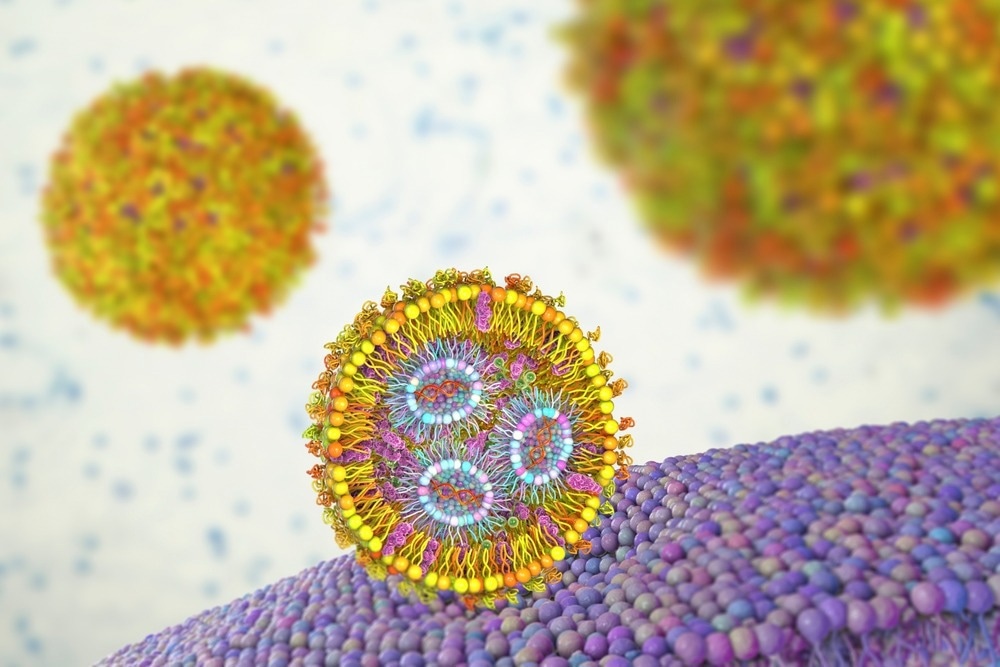Nanotechnology plays a major role in modern science, from computing to sensor diagnostics. The broad brushstroke term 'nanotechnology' covers a huge range of nanoscale structures. Here, AZoNano discusses the different types of nanoparticles.

Image Credit: Kateryna Kon/Shutterstock.com
What Are Nanoparticles?
Nanotechnology is involved in such a range of ground-breaking tech, thanks in part to the multitude of different nanoparticles available. Nanoparticles are defined as structures of matter measuring less than 100 nanometers (nm). Since the emergence of nanotechnology, researchers have realized that different nanoparticles exhibit different properties depending on their shape and size.
Nanomaterials have specific properties that distinguish them from other micro- to macroscale materials, such as a large surface area and surface-to-volume ratio, the ability to tailor their functionalities to various applications, and high surface energy.
Carbon nanotubes were discovered in 1991, and an abundance of other types of nanoparticles have been being introduced to science and industry ever since. Some of the different types of nanoparticles are discussed below.
What Are the Different Types of Nanoparticles?
Nanoparticles can be classified according to their size, morphology, dimension, and chemical properties. Here, we have discussed the different types in accordance with their chemical composition.1
Carbon-Based Nanoparticles
As the name suggests, carbon-based nanoparticles are made from carbon atoms. Most well known in this category are carbon nanotubes (CNTs) and fullerenes. These nanoparticles are usually used for structural reinforcement, as they are especially strong—in some cases 100 times stronger than steel.
CNTs can be further classified into single-walled carbon nanotubes (SWCNTs) and multi-walled carbon nanotubes (MWCNTs). CNTs are a significant structure in nanotechnology, characterized by their impressive length-to-diameter ratio of over 1,000,000. They are also appealing because of their unique conductivity: they are thermally conductive along the length and non-conductive across the tube.2
Fullerenes are carbon allotropes with a hollow cage structure of sixty or more carbon atoms. Buckminster fullerenes are composed of 60 carbon atoms in a hollow, football-like structure.
The carbon atoms in these materials are arranged in a pentagonal and hexagonal arrangement, and have a diverse variety of applications. Fullerenes have been used in many commercial applications because of their electrical conductivity, structure, high strength, and electron affinity.
So far, CNTs have been used to build transistors, aircraft, sensors and biosensors, drug delivery vehicles, batteries, and other energy storage devices. They are also used as a reinforcement in concrete and for water remediation.

Image Credit: nobeastsofierce/Shutterstock.com
Inorganic Nanoparticles
Ceramic
These types of nanoparticles are neither carbon-based or organic. They can be further categorized into metal, ceramic, and semiconductor nanoparticles.
Ceramic nanoparticles are typically thought to be made up of oxides, carbides, carbonates, and phosphates. They have high heat resistance and chemical inertness and are used in photocatalysis, photodegradation of dyes, and biological imaging.
One of the most important applications of ceramic nanoparticles is in drug delivery. By controlling their specific characteristics like size, surface area, porosity, and surface area-to-volume ratio, these nanomaterials perform as good drug delivery agents. They have been used effectively as a drug delivery system for several diseases like bacterial infections, glaucoma, and cancer. More recently, scientists have developed these nanoparticles for use in bone repair.
Download your PDF now!
Metal
Metal nanoparticles are types of nanoparticles prepared from metal precursors and can be synthesized by chemical, electrochemical, or photochemical methods.3
In chemical methods, the metal nanoparticles are obtained by reducing the metal-ion precursors in solution with chemical reducing agents. The resultant nanomaterials can adsorb small molecules and have high surface energy.
The most common types of metal nanoparticles include silver, gold, palladium, titanium, zinc, and copper nanoparticles.
Metal nanoparticles are utilized across several research fields, including the detection and imaging of biomolecules and in environmental and bioanalytical applications. For example, gold nanoparticles are used to coat the sample before scanning electron microscope (SEM) analysis to enhance SEM and produce high-quality electron microscopy images.
Metal nanoparticles also have important applications in drug delivery when they are extensively used for a variety of therapeutic agencies, including antibodies, nucleic acids, peptides, and more.

Image Credit: Kateryna Kon/Shutterstock.com
Semiconductor
Semiconductor nanoparticles are a type of nanoparticle with properties like those of metals and non-metals, and are found in the periodic table in groups II-VI, III-V or IV-VI. These nanoparticles have wide bandgaps, which upon tuning show different properties. Some examples of semiconductor nanoparticles are GaN, GaP, InP, InAs from group III-V, ZnO, ZnS, CdS, CdSe, CdTe are II-VI semiconductors and silicon and germanium are from group IV.
Semiconductor nanoparticles are applied to photocatalysis, electronics devices, nanophotonics and water-splitting applications. Modern devices such as computers, cell phones, television remote controls, satellite dishes, and fiber networks often contain semiconductor nanoparticles.
What are the latest trends in graphene tech?
Organic Nanoparticles
This class of nanoparticles is made up of proteins, carbohydrates, lipids, polymers, and any other organic compounds. They are particularly sensitive to heat and light, and have a more labile nature than other nanoparticles as they are often formed by non-covalent intermolecular interactions.4
Polymeric
These organic nanoparticles can have varying structures depending on their preparation method. For example, some form nanocapsules or nanospheres, others nanogels or nanomicelles.5
Nanospheres have a matrix-like structure, and the active compounds and polymer in these materials are uniformly dispersed. In contrast, nanocapsules, with their core-shell structure, have active compounds confined in the centre surrounded by a polymer shell.
Some advantages of polymeric nanoparticles include controlled release, protection of drug molecules as they travel within the internal and external environment, the ability to combine therapy and imaging, and specific targeting.
Polymeric nanoparticles are most commonly seen in drug delivery and diagnostics. Drug delivery systems with polymeric nanoparticles have the benefit of being highly biodegradable and biocompatible.
Lipid
Lipid nanoparticles are generally spherical, with a diameter ranging from ten to 100 nm. Their structure consists of a solid core made of lipids and a matrix containing soluble lipophilic molecules, with surfactants and emulsifiers stabilizing the external core.6
This type of nanoparticle is also seen in the biomedical field as a drug carrier and RNA release in cancer therapy. In particular, lipid nanoparticles have been successful in drug transportation and delivering poorly water-soluble oligonucleotides in gene therapy applications.

Image Credit: Kateryna Kon/Shutterstock.com
Impact of Nanoparticles on the Future of Nanotechnology
The discovery and subsequent innovations in nanoparticles have propelled nanotechnology's advance, resulting in life-saving drug-delivery systems and boosting efficiency in countless industrial processes.7
Nanotechnology at the Frontiers of Medicine
Video Credit: Nano Help/YouTube.com
As the field of nanotechnology advances, the construction and synthesis of functional nanoparticles for applications across the pharmaceutical, energy generation, electrical, computing, and chemical engineering sectors will continue. In the future, we will likely see more applications of different types of nanoparticles emerge, with a key focus on medical applications.
References and Further Reading
- Joudeh N. and Linke D. (2022) "Nanoparticle classification, physicochemical properties, characterization, and applications: a comprehensive review for biologists", Journal of Nanobiotechnology, 20 (262). Available at: https://jnanobiotechnology.biomedcentral.com/articles/10.1186/s12951-022-01477-8
- Syduzzaman M. et al, (2025) "Carbon nanotubes: Structure, properties and applications in the aerospace industry" Results in Materials 25. Available at: https://www.sciencedirect.com/science/article/pii/S2590048X24001286
- Chandrakala, V., Aruna, V. and Angajala, G. (2022) “Review on metal nanoparticles as Nanocarriers: Current challenges and perspectives in Drug Delivery Systems,” Emergent Materials, 5(6), pp. 1593–1615. Available at: https://doi.org/10.1007/s42247-021-00335-x.
- Ealia S. A. M. and Saravanakumar M. O. (2017) "A review on the classification, characterisation, sunthesis of nanoparticles and their application" IOP Conference Series: Materials Science and Engineering 263. Available at: https://iopscience.iop.org/article/10.1088/1757-899X/263/3/032019
- Crucho, C. and Barros, M., (2017) “Polymeric nanoparticles: A study on the preparation variables and characterization methods,” Materials Science and Engineering: C, 80, pp.771-784. Available at: https://doi.org/10.1016/j.msec.2017.06.004
- Musielak, E., Feliczak-Guzik, A. and Nowak, I. (2022) “Synthesis and potential applications of lipid nanoparticles in medicine,” Materials, 15(2), p. 682. Available at: https://doi.org/10.3390/ma15020682.
- Khan, I., Saeed, K. and Khan, I., (2019) “Nanoparticles: Properties, applications and toxicities,” Arabian Journal of Chemistry, 12(7), pp.908-931. Available at: https://www.sciencedirect.com/science/article/pii/S1878535217300990.
- Thomas, S., Harshita, B., Mishra, P. and Talegaonkar, S., (2015). "Ceramic Nanoparticles: Fabrication Methods and Applications in Drug Delivery,” Current Pharmaceutical Design, 21(42), pp.6165-6188. Available at: https://doi.org/10.2174/1381612821666151027153246.
Disclaimer: The views expressed here are those of the author expressed in their private capacity and do not necessarily represent the views of AZoM.com Limited T/A AZoNetwork the owner and operator of this website. This disclaimer forms part of the Terms and conditions of use of this website.